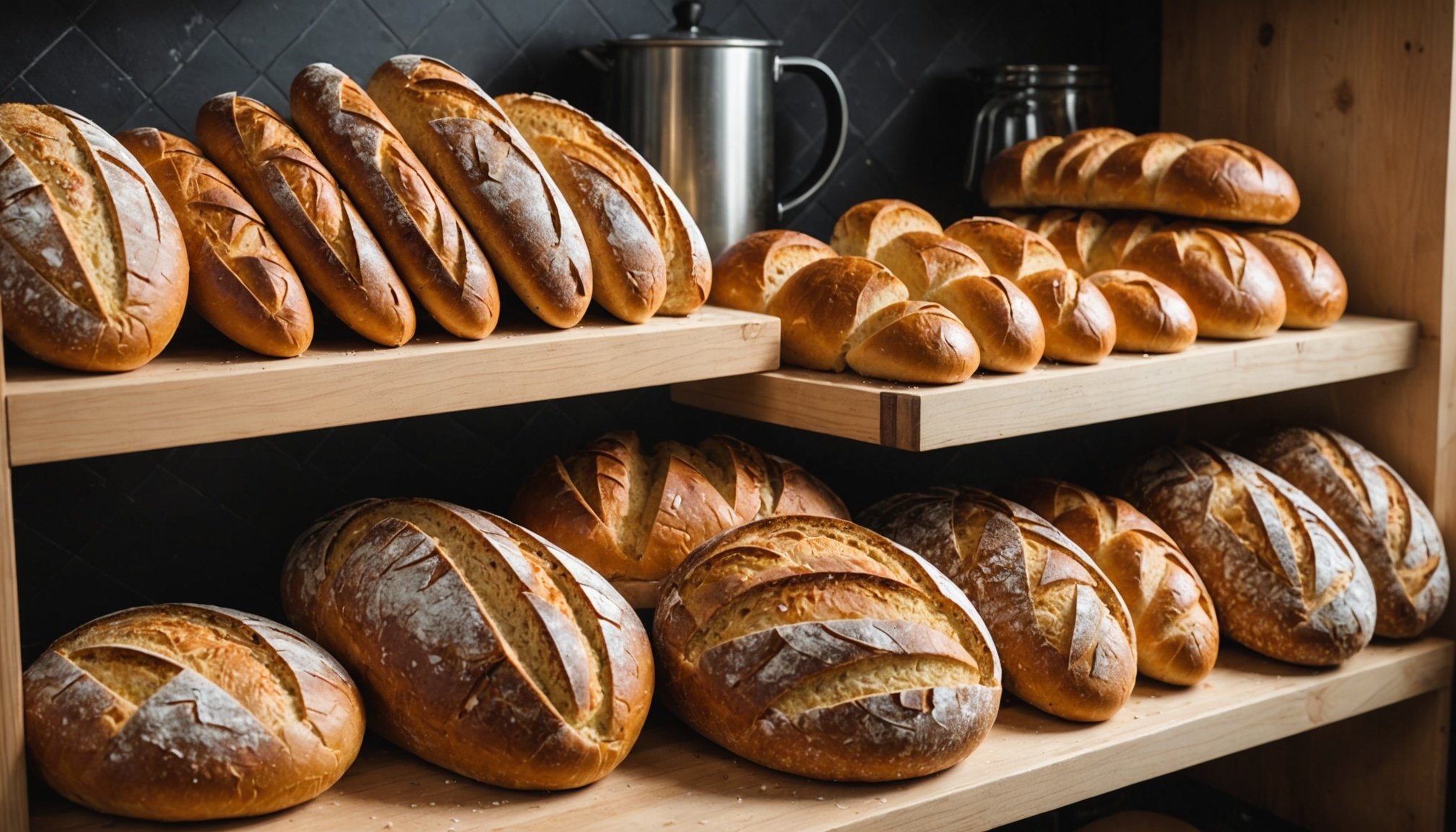Stale bread can feel like a familiar foe in small kitchens. Keeping your loaves fresh while minimizing waste is a common struggle. Effective bread storage solutions can transform your culinary experience, saving you both money and frustration. This guide explores innovative strategies tailored for compact kitchens, ensuring your bread remains delectable longer. Discover practical tips to optimize freshness and create space-saving storage solutions. Your love for bread deserves it!
Effective Bread Storage Solutions
Maintaining bread freshness is a common challenge, and choosing the right bread storage methods is crucial. Traditionally, bread is stored in paper bags, plastic bags, or bread boxes. Each method has its pros and cons. For instance, while plastic bags keep moisture in, they can cause bread to become soggy. On the other hand, paper bags allow for air circulation but may lead to quicker drying.
Also read : Effective Strategies for Creating a Low-Height Snack Drawer to Curb Overeating in Kids
For those with limited space, innovative storage solutions are available. Compact bread bins that fit snugly on countertops or wall-mounted options can save space while keeping bread fresh. Vacuum-sealed containers are another excellent choice, as they remove air and preserve freshness longer.
When comparing the effectiveness of these methods, consider the type of bread and your storage environment. Bread boxes are ideal for crusty loaves, maintaining a balance between moisture and air circulation. Meanwhile, vacuum-sealed containers are perfect for those who prefer longer storage without sacrificing quality.
Also read : Ideal Positions for Kitchen TVs or Screens: Minimize Distractions While Cooking!
Ultimately, the best method depends on personal preference and space availability. By selecting the right storage solution, you can enjoy fresh bread for longer, reducing waste and enhancing your culinary experience.
Product Recommendations for Bread Storage
Choosing the right bread storage products can enhance your kitchen organization and keep your bread fresh longer. Let's explore some of the best options available.
Top-rated Bread Boxes for Compact Kitchens
For those with limited space, selecting a bread box that fits snugly in your kitchen is crucial. Look for compact designs that provide ample storage without taking up too much room. Stainless steel bread boxes are popular for their durability and sleek appearance. Additionally, wooden bread boxes offer a classic look and natural moisture balance, making them ideal for crusty loaves.
Space-saving Bags and Wraps for Bread
If a bread box isn't feasible, consider space-saving bags and wraps. Reusable silicone bags are an eco-friendly choice that keeps bread fresh by preventing moisture loss. They are easy to clean and store, making them a versatile option for any kitchen. Meanwhile, beeswax wraps provide a sustainable alternative, allowing for air circulation while maintaining freshness.
Review of Vacuum-seal Options for Bread Storage
For those seeking longer storage, vacuum-seal options are worth considering. These containers remove air, significantly extending the shelf life of your bread. They are particularly useful for bulk purchases or homemade bread, ensuring you enjoy fresh slices without frequent trips to the store.
Techniques to Maintain Bread Freshness
Keeping bread fresh involves understanding the best bread freshness tips and employing effective bread preservation techniques. To start, wrapping bread properly is essential. Use a combination of materials: a paper wrap inside a plastic bag can help maintain moisture balance, preventing bread from becoming too soggy or too dry.
Temperature and humidity play significant roles in bread preservation. Store bread in a cool, dry place to prevent mold growth. Avoid storing bread in the refrigerator, as this accelerates staling. Instead, consider a bread box or a pantry shelf where temperature and humidity are stable.
For longer storage, freezing is an excellent option. To freeze effectively, slice the bread first, then wrap it tightly in plastic wrap or aluminum foil before placing it in a freezer bag. This prevents freezer burn and maintains freshness. When thawing, leave the bread at room temperature for the best texture and flavour. If you're in a hurry, use a toaster for quick thawing.
By understanding the impact of temperature, humidity, and proper wrapping, you can significantly extend the shelf life of your bread, ensuring it remains fresh and delicious for as long as possible.
Troubleshooting Common Bread Storage Issues
Navigating bread storage problems can be tricky, especially when dealing with mold and staling. Understanding these issues is key to maintaining freshness.
Identifying Signs of Spoilage
Spotting spoilage early can save your bread. Look for signs like unusual odours, fuzzy spots, or a hard texture. These indicate mold or staling. Mold prevention starts with recognising these signs promptly, allowing you to take action before the bread is beyond saving.
Solutions for Common Mold Problems
Mold thrives in warm, damp environments. To prevent it, ensure your bread storage area is cool and dry. A bread box with proper ventilation can help by balancing humidity. If mold appears, discard the affected parts immediately to prevent spreading. Consider using airtight containers or rotating your bread supply to keep it fresh.
Strategies to Combat Stale Bread
Stale bread is not only hard but loses flavour. Combatting bread staling involves maintaining moisture without making it soggy. Wrapping bread in a paper towel inside a plastic bag can help. For a quick fix, sprinkle stale slices with water and warm them in the oven. This restores some moisture, rejuvenating the texture and taste.
Visuals and Infographics for Bread Storage
Incorporating bread storage visualization into your kitchen routine can significantly enhance your understanding and efficiency. Visual aids such as infographics provide a quick reference for selecting the best storage methods, helping you make informed decisions without sifting through extensive text.
Infographics are particularly effective because they distill complex information into digestible visuals. For instance, an infographic might illustrate the pros and cons of different storage options, such as bread boxes versus vacuum-sealed containers, using simple icons and concise text. This approach not only saves time but also aids in retaining information.
User-generated visuals are another valuable resource. Many individuals share their personal storage solutions online, offering real-life examples of how to maximize kitchen space efficiency. These visuals might display creative uses of compact bread bins or the organization of reusable bags and wraps in limited spaces. By observing these setups, you can adapt similar strategies to fit your own kitchen needs.
Embracing visual aids in your bread storage journey can transform the way you preserve your bread, ensuring it remains fresh and delicious while optimizing your kitchen space.
User Testimonials and Success Stories
Exploring bread storage success stories can provide valuable insights into effective methods and common pitfalls. Many users have shared their experiences, revealing practical kitchen organization tips that enhance bread freshness.
One user described how switching to a vacuum-sealed container transformed their bread storage routine. They noted an immediate improvement in freshness, with bread staying soft and mold-free for up to two weeks. The airtight seal was particularly beneficial in humid climates, where bread typically spoils faster.
Another testimonial highlighted the advantages of using a wooden bread box. This user found that it maintained the perfect moisture balance for crusty loaves, preventing them from becoming stale. The natural material also added a touch of elegance to their kitchen decor.
Lessons learned from these user experiences include the importance of assessing your environment and bread type before choosing a storage method. For instance, those living in humid areas might benefit more from airtight solutions, while those in drier climates could opt for breathable storage options.
By learning from these real-life examples, you can tailor your bread storage approach to suit your specific needs, ensuring your bread remains fresh and delicious for longer.











